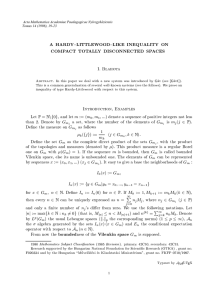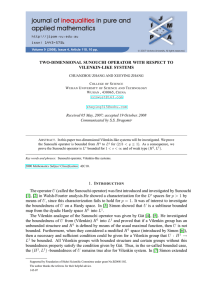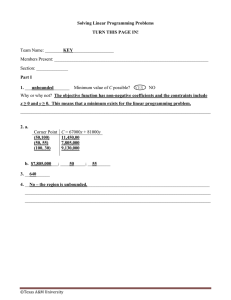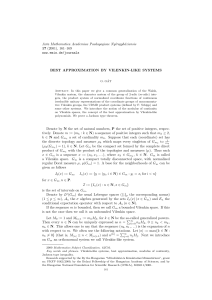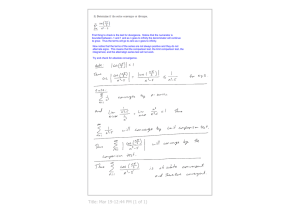Acta Mathematica Academiae Paedagogicae Ny´ıregyh´aziensis 20 (2004), 141–152 www.emis.de/journals ISSN 1786-0091
advertisement
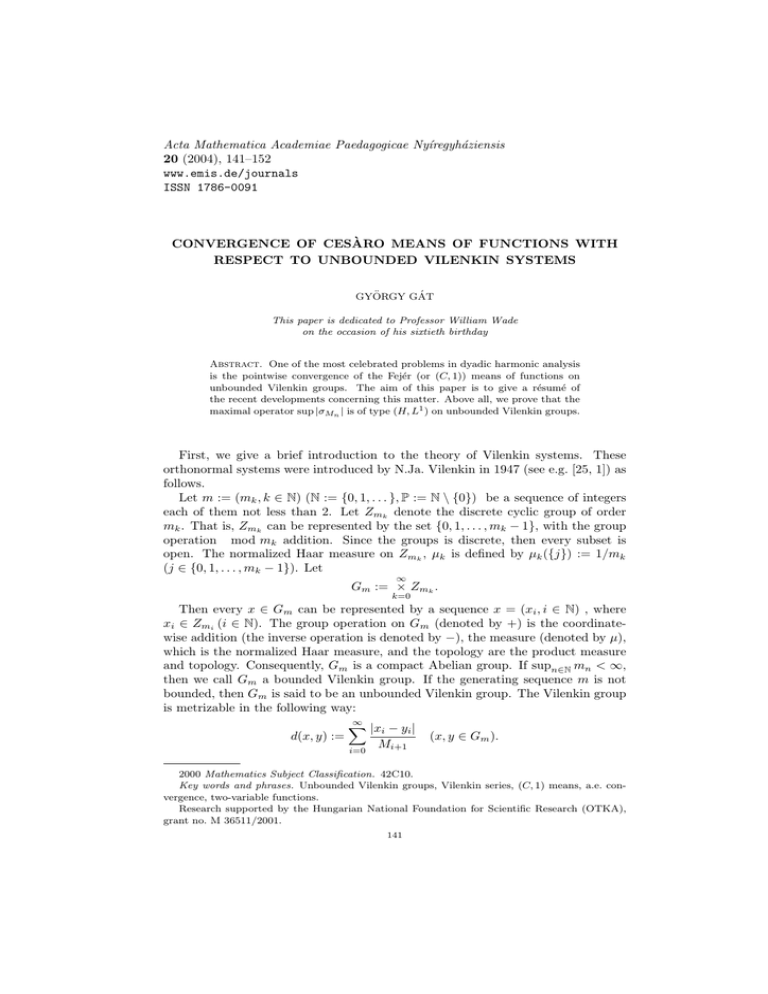
Acta Mathematica Academiae Paedagogicae Nyı́regyháziensis
20 (2004), 141–152
www.emis.de/journals
ISSN 1786-0091
CONVERGENCE OF CESÀRO MEANS OF FUNCTIONS WITH
RESPECT TO UNBOUNDED VILENKIN SYSTEMS
GYÖRGY GÁT
This paper is dedicated to Professor William Wade
on the occasion of his sixtieth birthday
Abstract. One of the most celebrated problems in dyadic harmonic analysis
is the pointwise convergence of the Fejér (or (C, 1)) means of functions on
unbounded Vilenkin groups. The aim of this paper is to give a résumé of
the recent developments concerning this matter. Above all, we prove that the
maximal operator sup |σMn | is of type (H, L1 ) on unbounded Vilenkin groups.
First, we give a brief introduction to the theory of Vilenkin systems. These
orthonormal systems were introduced by N.Ja. Vilenkin in 1947 (see e.g. [25, 1]) as
follows.
Let m := (mk , k ∈ N) (N := {0, 1, . . . }, P := N \ {0}) be a sequence of integers
each of them not less than 2. Let Zmk denote the discrete cyclic group of order
mk . That is, Zmk can be represented by the set {0, 1, . . . , mk − 1}, with the group
operation mod mk addition. Since the groups is discrete, then every subset is
open. The normalized Haar measure on Zmk , µk is defined by µk ({j}) := 1/mk
(j ∈ {0, 1, . . . , mk − 1}). Let
∞
Gm := × Zmk .
k=0
Then every x ∈ Gm can be represented by a sequence x = (xi , i ∈ N) , where
xi ∈ Zmi (i ∈ N). The group operation on Gm (denoted by +) is the coordinatewise addition (the inverse operation is denoted by −), the measure (denoted by µ),
which is the normalized Haar measure, and the topology are the product measure
and topology. Consequently, Gm is a compact Abelian group. If supn∈N mn < ∞,
then we call Gm a bounded Vilenkin group. If the generating sequence m is not
bounded, then Gm is said to be an unbounded Vilenkin group. The Vilenkin group
is metrizable in the following way:
∞
X
|xi − yi |
d(x, y) :=
(x, y ∈ Gm ).
Mi+1
i=0
2000 Mathematics Subject Classification. 42C10.
Key words and phrases. Unbounded Vilenkin groups, Vilenkin series, (C, 1) means, a.e. convergence, two-variable functions.
Research supported by the Hungarian National Foundation for Scientific Research (OTKA),
grant no. M 36511/2001.
141
142
GYÖRGY GÁT
The topology induced by this metric, the product topology, and the topology given
by intervals defined below, are the same. A base for the neighborhoods of Gm can
be given by the intervals:
I0 (x) := Gm ,
In (x) := {y = (yi , i ∈ N) ∈ Gm : yi = xi for i < n}
for x ∈ Gm , n ∈ P. Let 0 = (0, i ∈ N) ∈ Gm denote the nullelement of Gm .
Furthermore, let Lp (Gm ) (1 ≤ p ≤ ∞) denote the usual Lebesgue spaces (k.kp the
corresponding norms) on Gm , An the σ-algebra generated by the sets In (x) (x ∈
Gm ), and En the conditional expectation operator with respect to An (n ∈ N)
(f ∈ L1 ).
The concept of the maximal Hardy space ([21]) H 1 (Gm ) is defined by the
maximal function f ∗ := supn |En f | (f ∈ L1 (Gm )), saying that f belongs to the
Hardy space H 1 (Gm ) if f ∗ ∈ L1 (Gm ). H 1 (Gm ) is a Banach space with the norm
kf kH 1 := kf ∗ k1 .
The so-called atomic Hardy space H(Gm ) is defined for bounded Vilenkin groups
as follows [21, 22]. A function a ∈ L∞ (Gm ) is called an Ratom, if either a = 1 or a
has the following properties: supp a ⊆ Ia , kak∞ ≤ µ(I1a ) , Ia a = 0 , where Ia ∈ I :=
{In (x) : x ∈ Gm , n ∈ N}. The elements of I are called intervals on Gm
P. ∞We say
that the function f belongs to H(Gm ) , if f can be represented
as
f
=
i=0 λi ai ,
P∞
|λ
|
<
∞
is
true. It
where ai -s are atoms and for the coefficients λi (i ∈ N)
i
i=0
is known that H(Gm ) is a Banach space with respect to the norm
kf kH := inf
∞
X
|λi |,
i=0
where the infinum is taken all over decompositions
f=
∞
X
λi ai ∈ H(Gm ).
i=0
If the sequence m is not bounded, then we define the set of intervals in a different
way [22], that is we have “more” intervals than in the bounded case.
A set IS⊂ Gm is called an interval if for some x ∈ Gm and n ∈ N0 , I is of the
form I = k∈U In (x, k) where U is one of the following sets
½
·
¸ ¾
½·
¸
¾
mn
mn
U1 = 0, . . . ,
−1 , U2 =
, . . . , mn − 1
2
2
½
·
¸ ¾
½·
¸
·
¸ ¾
[mn /2] − 1
[mn /2] − 1
mn
U3 = 0, . . . ,
−1 , U4 =
−1, . . . ,
−1 , . . .
2
2
2
etc., and In (x, k) := {y ∈ Gm : yj = xj (j < n), yn = k} , (x ∈ Gm , k ∈ Zmn , n ∈
N0 ). The rest of the definition of the atomic Hardy space H is the same as in the
bounded case.
It is known that if the sequence m is bounded, then H 1 = H , otherwise H is a
proper subset of H 1 [16].
We say that the function f ∈ L1 (Gm ) belongs to the logarithm space L log+L(Gm )
if the integral
Z
kf kL log+ L :=
|f (x)| log+ (|f (x)|)dµ(x)
Gm
CONVERGENCE OF CESÀRO MEANS
143
is finite. The positive logarithm log+ is defined as
(
x if x > 1,
+
log (x) :=
0 otherwise .
Let X and Y be either H 1 (Gm ) or Lp (Gm ) for some 1 ≤ p ≤ ∞ with norms
k.kX and k.kY . We say that operator T is of type (X, Y ) if there exist an absolute
constant C > 0 for which kT f kY ≤ Ckf kX for all f ∈ X. If X = Y = Lp (Gm )
then we often say that T is of type (p, p) instead of type (Lp , Lp ). T is of weak type
(L1 , L1 ) (or weak type (1, 1)) if there exist an absolute constant C > 0 for which
µ(T f > λ) ≤ Ckf k1 /λ for all λ > 0 and f ∈ L1 (Gm ). It is known that the operator
which maps a function f to the maximal function f ∗ is of weak type (L1 , L1 ), and
of type (Lp , Lp ) for all 1 < p ≤ ∞ (see e.g. [3]).
Let M0 := 1, Mn+1 := mn Mn (n ∈ N) be the so-called generalized powers. Then
each natural number n can be uniquely expressed as
n=
∞
X
ni Mi
(ni ∈ {0, 1, . . . , mi − 1}, i ∈ N),
i=0
where only a finite number of ni -s differ from zero. The generalized Rademacher
functions are defined as
√
xn
rn (x) := exp(2πı
) (x ∈ Gm , n ∈ N, ı := −1).
mn
(
Pmn −1 i
0
, if xn 6= 0,
(x ∈ Gm , n ∈ N). The nth
It is known that i=0 rn (x) =
mn , if xn = 0
Vilenkin function is
∞
Y
n
ψn :=
rj j (n ∈ N).
j=0
The system ψ := (ψn : n ∈ N) is called a Vilenkin system. Each ψn is a character
of Gm , and all the characters of Gm are of this form. Define the m -adic addition
as
∞
X
k ⊕ n :=
(kj + nj ( mod mj ))Mj (k, n ∈ N).
j=0
Then , ψk⊕n = ψk ψn , ψn (x + y) = ψn (x)ψn (y), ψn (−x) = ψ̄n (x), |ψn | = 1 (k, n ∈
N, x, y ∈ Gm ).
Define the Fourier coefficients, the partial sums of the Fourier series, the Dirichlet
kernels, the Fejér means, and the Fejér kernels with respect to the Vilenkin system
ψ as follows
Z
n−1
n−1
X
X
fˆ(k)ψk , Dn (y, x) = Dn (y − x) :=
ψk (y)ψ̄k (x),
fˆ(n) :=
f ψ̄n , Sn f :=
Gm
σn f :=
1
n
n−1
X
k=0
k=0
Sk f, Kn (y, x) = Kn (y − x) :=
k=0
Z
(n ∈ P, y, x ∈ Gm , fˆ(0) :=
1
n
n−1
X
Dk (y − x),
k=0
f, S0 f = D0 = K0 = 0, f ∈ L1 (Gm )).
Gm
144
GYÖRGY GÁT
It is well-known that
Z
Sn f (y) =
f (x)Dn (y − x)dµ(x),
Gm
Z
σn f (y) =
f (x)Kn (y − x)dµ(x) (n ∈ P, y ∈ Gm , f ∈ L1 (Gm )).
Gm
It is also well-known that
(
Mn
0
Z
SMn f (x) = Mn
if x ∈ In (0)
,
if x ∈
/ In (0)
DMn (x) =
(f ∈ L1 (Gm ), n ∈ N).
f = En f (x)
In (x)
Next we introduce some notation with respect to the theory of two-dimensional
Vilenkin systems. Let m̃ be a sequence like m. The relation between the sequence
(m̃n ) and (M̃n ) is the same as between sequence (mn ) and (Mn ). The group
Gm × Gm̃ is called a two-dimensional Vilenkin group. The normalized Haar measure is denoted by µ, just as in the one-dimensional case. It will not cause any
misunderstood.
The two-dimensional Fourier coefficients, the rectangular partial sums of the
Fourier series, the Dirichlet kernels, the Fejér means, and the Fejér kernels with
respect to the two-dimensional Vilenkin system are defined as follows:
Z
fˆ(n1 , n2 ) :=
f (x1 , x2 )ψ̄n1 (x1 )ψ̄n2 (x2 )dµ(x1 , x2 ),
Gm ×Gm̃
Sn1 ,n2 f (y 1 , y 2 ) :=
nX
1 −1 n
2 −1
X
fˆ(k1 , k2 )ψk1 (y 1 )ψk2 (y 2 ),
k1 =0 k2 =0
Dn1 ,n2 (y, x) = Dn1 (y 1 − x1 )Dn2 (y 2 − x2 )
:=
nX
1 −1 n
2 −1
X
ψk1 (y 1 )ψk2 (y 2 )ψ̄k1 (x1 )ψ̄k2 (x2 ),
k1 =0 k2 =0
σn1 ,n2 f :=
n1 −1 nX
2 −1
1 X
Sk1 ,k2 f,
n1 n2
k1 =0 k2 =0
Kn1 ,n2 (y, x) = Kn1 ,n2 (y − x) :=
n1 −1 nX
2 −1
1 X
Dk1 ,k2 (y − x),
n1 n2
k1 =0 k2 =0
1
2
1
2
(y = (y , y ), x = (x , x ) ∈ Gm × Gm̃ ).
It is also well-known that
σn1 ,n2 f (y) =
SMn
1
,M̃n2
Z
f (x)Kn1 ,n2 (y − x)dµ(x),
Z
f (x) = Mn1 M̃n2
f = (En1 1 ⊗ En2 2 )f (x).
Gm ×Gm̃
In1 (x1 )×In2 (x2 )
One of the most celebrated problems in dyadic harmonic analysis is the pointwise
convergence of the Fejér (or (C, 1)) means of functions on one and two-dimensional
unbounded Vilenkin groups.
CONVERGENCE OF CESÀRO MEANS
145
Fine [4] proved every Walsh-Fourier series (in the Walsh case mj = 2 for all
j ∈ N) is a.e. (C, α) summable for α > 0. His argument is an adaptation of
the older trigonometric analogue due to Marcinkiewicz [12]. Schipp [19] gave a
simpler proof for the case α = 1, i.e. σn f → f a.e. (f ∈ L1 (Gm )). He proved that
σ ∗ = sup |σn |, h ∈ N is of weak type (L1 , L1 ). That σ ∗ is bounded from H 1 to L1
was discovered by Fujii [6].
The theorem of Schipp are generalized to the p-series fields (mj = p for all j ∈ N)
by Taibleson [24], and later to bounded Vilenkin systems by Pál and Simon [16].
Now, what about the Vilenkin groups with unbounded generating sequences?
The methods known in the trigonometric or in the Walsh, bounded Vilenkin case
are not powerful enough. One of the main problems is that the proofs on the
bounded Vilenkin groups (or in the trigonometric case) heavily use the fact that
the L1 norm of the Fejér kernels are uniformly bounded. This is not the case if the
group Gm is an unbounded one [17]. From this it follows that the original theorem
of Fejér does not hold on unbounded Vilenkin groups. Namely, Price proved [17]
that for an arbitrary sequence m (supn mn = ∞) and a ∈ Gm there exists a function
f continuous on Gm and σn f (a) does not converge to f (a). Moreover, he proved
n
[17] that if logMm
→ ∞ , then there exists a function f continuous on Gm whose
n
Fourier series are not (C, 1) summable on a set S ⊂ Gm which is non-denumerable.
On the other hand, Nurpeisov gave [15] a necessary and sufficient condition of the
uniform convergence of the Fejér means σMn f of continuous functions on unbounded
Vilenkin groups. Namely, define the uniform modulus of continuity as
ωn (f ) :=
sup
|f (x + h) − f (x)|.
h∈In (0),x∈Gm
Nurpeisov proved [15]: A necessary and sufficient condition that the means σMn f
of the Fourier series of the continuous function f converge uniformly to f on an
unbounded Vilenkin group for all such an f is that
ωn−1 (f ) log(mn ) = o(1).
Since the uniform modulus of continuity can be any nonincreasing real sequence
which converges to zero (for the proof see [18, 5]), then as a consequence of this
it is possible to give a sequence m increasing enough fast, and a function even in
the Lipschitz class Lip(1), such that the Mn th Fejér means do not converge to the
function uniformly.
So, it seems that it is impossible to give a (Hölder) function class such that the
uniform convergence of the Fejér means would hold for all functions in this class if
there is no condition on sequence m at all.
On the other hand, mean convergence of the full partial sums for Lp , p > 1, is
known for the unbounded case. For the proof see [20]. This trivially implies the
norm convergence σn f → f for all f ∈ Lp , where 1 < p < ∞.
What about the a.e. convergence? Simon proved [22] that the maximal operator
σ ∗ is of type (H, L1 ) if and only if the Vilenkin group is a bounded one. It does not
sound good in the point of view of the a.e. convergence, since in the bounded case,
the method of the proof of the a.e. relation σn f → f (f ∈ L1 ) implies that σ ∗ is
of type (H, L1 ). However, below we prove that if we take the maximal function of
the partial sequence of the Fejér means σMn in place of the whole sequence, then
we get an operator of type (H, L1 ) regardless of the boundedness of m.
146
GYÖRGY GÁT
Concerning the a.e. convergence we can say a bit more. Namely, in 1999 the author [8] proved that if f ∈ Lp (Gm ), where p > 1, then σn f → f almost everywhere.
This was the very first “positive” result with respect to the a.e. convergence of the
Fejér means of functions on unbounded Vilenkin groups.
In 2001 Simon proved [23] the following theorem with respect to the Fejér means
of L1 functions. A sequence m is said to be strong quasi-bounded if
1
n−1
X
Mn+1
j=0
Mj+1 < C log mn .
Then every bounded m is quasi-bounded, and there are also some unbounded ones.
Let m is strong quasi-bounded. Then for all f ∈ L1 (Gm )
σMn f (x) − f (x) = o(max(log m0 , . . . , mn−1 )).
Later, in 2003, the author of this paper improved [10] this result, and gave a partial
answer for L1 case. He discussed this partial sequence of the sequence of the Fejér
means. Namely, if f ∈ L1 (Gm ), then he proved (see [10]) that σMn f → f almost
everywhere, where m is any sequence. In my opinion, it is highly likely that the
methods of the papers [8, 10] can be applied and improved in order to prove the
a.e. relation σn f → f for all f ∈ L log+ L and m. Anyway, it is not an easy task. . .
What can be said in the case of two-dimensional functions? This is “another
story”. For double trigonometric Fourier series Marcinkiewicz and Zygmund [13]
proved that σm,n f → f a.e. as m, n → ∞ provided the integral lattice points
(m, n) remain in some positive cone, that is provided β −1 ≤ m/n ≤ β for some
fixed parameter β ≥ 1. It is known that the classical Fejér means are dominated by
decreasing functions whose integrals are bounded but this fails to hold for the onedimensional Walsh-Fejér kernels. This growth difference is exacerbated in higher
dimensions so that the trigonometric techniques are not powerful enough for the
Walsh case.
In 1992 Móricz, Schipp and Wade [14] proved that σ2n1 ,2n2 f → f a.e. for each
f ∈ L1 ([0, 1)2 ), when n1 , n2 → ∞, |n1 − n2 | ≤ α for some fixed α. Later, Gát and
Weisz proved (independently, in the same year) this for the whole sequence, that
is, the theorem of Marcinkiewicz and Zygmund with respect to the Walsh-Paley
system (see [7] and [27]). In 2000 Blahota and the author of this paper generalized
this theorem with respect to two-dimensional bounded Vilenkin systems [2].
If we do not provide a “cone restriction” for the indices in σn,k f that is, we discuss
the convergence of this two-dimensional Fejér means in the Pringsheim sense, then
the situation changes. In 1992 Móricz, Schipp and Wade [14] proved with respect
to the Walsh-Paley system that σn,k f → f a.e. for each f ∈ L log+ L([0, 1)2 ),
when min {n, k} → ∞. Later, in 2002 Weisz generalized [28] this with respect
to two-dimensional bounded Vilenkin systems. In 2000 Gát proved [9] that the
theorem of Móricz, Schipp and Wade above can not be improved. Namely, let
δ : [0, +∞) → [0, +∞) be a measurable function with property limt→∞ δ(t) = 0.
Gát proved the existence of a function f ∈ L1 ([0, 1)2 ) such that f ∈ L log+ Lδ(L),
and σn,k f does not converge to f a.e. as min{n, k} → ∞.
What can be said in the two-dimensional case with respect to unbounded Vilenkin
systems? In 1997 Wade proved [26] the following. Let
βk,j := max {m0 , . . . , mk−1 , m̃0 , . . . , m̃j−1 } .
CONVERGENCE OF CESÀRO MEANS
147
The sequence m is called δ-quasi bounded, 0 ≤ δ < 1, if the sums
n−1
X
mj /(mj+1 . . . mn )δ
j=0
are (uniformly) bounded. Let the generating sequences m, m̃ be δ-quasi bounded.
Then for all f ∈ L1 (Gm × Gm̃ ) we have
2r
),
σMn ,M̃k f (x) − f (x) = o(βn,k βn+r,k+r
as n, k → ∞, provided that |n − k| < α, where α, r ∈ N are some constants for
almost every x ∈ Gm × Gm̃ .
On the other hand, there was nothing concerning the pointwise convergence
before the following manuscript of the author. In [11] he proved the following
theorem. Let f ∈ (L log+ L)(Gm × Gm̃ ). Then we have σMn ,M̃n f → f almost
1
2
everywhere, where min {n1 , n2 } → ∞ provided that the distance of the indices is
bounded, that is, |n1 − n2 | < α for some fixed constant α > 0. Here it is necessary
to emphasize that in this paper m, m̃ can be any sequences.
At last, we prove a (H, L) type inequality with respect to the one-dimensional
Fejér means of integrable function on unbounded Vilenkin groups. Define the maximal operator σ † f := supn∈N |σMn f |, where f is an integrable function.
Theorem 1. Let f ∈ H(Gm ). Then we have
kσ † f k1 ≤ Ckf kH .
In order to prove this theorem we need a modified Calderon-Zygmund decomposition lemma due to Simon: on unbounded Vilenkin groups (see [22]). For
z ∈ Gm , k ∈ N, j ∈ {0, . . . , mk − 1} we use the notation
Ik (z, j) = Ik+1 (z0 , . . . , zk−1 , j).
Lemma 2. Let f ∈ L1 (Gm ), and λ > kf k1 > 0 arbitrary. Then the function f
can be decomposed in the following form:
f = f0 +
∞
X
fj ,
kf0 k∞ ≤ Cλ,
kf0 k1 ≤ Ckf k1 ,
j=1
supp fj ⊂
βj
[
Z
Ikj (z j , l) = Jj ,
l=αj
and for
F =
[
Jj ,
fj d µ = 0
µ(F ) ≤ C
j∈P
(j ∈ P),
Gm
kf k1
.
λ
Moreover, the sets Jj are disjoint (j ∈ P).
Proof of Theorem 1. Basically, the proof is a kind of application of the results in
[10]. Namely, for an integrable function f we define the following operator:
¯
¯
Z
¯
¯
1
¯
¯
H1 f (y) := sup ¯MA−1 S
dµ(x)¯ .
f (x)
¯
¯
1
−
r
(y
−
x)
A−1
A∈N
IA (y0 ,...,yA−2 ,xA−1 )
x
6=y
A−1
A−1
148
GYÖRGY GÁT
In [10] we proved that the operator H1 is of type (L2 , L2 ). Let f ∈ L1 (Gm ) such
that
Z
β
[
f dµ = 0, supp f ⊂
Ik (z, j) =: I,
Gm
j=α
where Ik (z, j) = Ik+1 (z0 , . . . , zk−1 , j), z ∈ Gm , and
j ∈ {α, α + 1, . . . , β} ⊂ {0, 1, . . . , mk − 1}.
Let γ := b(α + β)/2c. Define the distance of j, k ∈ {0, 1, . . . , mk − 1} = Zmk as
(
|j − k|,
if |j − k| ≤ m2k ,
ρ(j, k) :=
mk − |j − k|, if |j − k| > m2k .
In other words, Zmk is considered as a circle. Define the set 6I in the following
way: If β − α + 1 ≥ mk /6, then 6[α, β] := {0, . . . , mk − 1},
[
6I :=
Ik (z, j) = Ik (z).
j∈6[α,β]
On the other hand, if β − α + 1 < mk /6, then
6[α, β] := {j ∈ Zmk : ρ(j, γ) ≤ 3(β − α + 1)} ,
[
6I :=
Ik (z, j).
j∈6[α,β]
It is obvious that µ(I) ≤ µ(6I) ≤ 6µ(I). In [10, Lemma 2.4] Gát proved:
Z
|H1 f (y)| dµ(y) ≤ Ckf k1 .
Gm \6I
More or less, H1 seems like a quasi-local operator (for the exact definition of quasilocal operators see e.g. [21]). Then, by standard argument, with application of the
theorem of Cauchy and Buniakovskii, we have for an atom a,
supp a ⊂
β
[
Ik (z, j) =: I,
j=α
that
Z
kH1 ak1 =
Z
|H1 ay)| dµ(y) +
Gm \6I
|H1 a(y)| dµ(y)
6I
≤ Ckak1 + k16I k2 kH1 ak2 ≤ Ckak1 + C
p
µ(6I)kak2 ≤ C.
This immediately gives for all f ∈ H that
(1)
kH1 f k1 ≤ Ckf kH .
For any 1 ≤ j ∈ N define the operator Hj in the following way
¯
Z
¯
¯
Hj f (y) := sup ¯MA−j S
f (x)
j≤A∈N ¯
xA−j 6=yA−j IA (y0 ,...,yA−j−1 ,xA−j ,...,yA−1 )
¯
¯
1
dµ(x)¯¯ ,
×
1 − rA−j (y − x)
CONVERGENCE OF CESÀRO MEANS
149
where y ∈ Gm . Hereinafter, we prove for the operator Hj :
j
kf kH
2j
for all f ∈ H. The proof applies inequality (1) for a modified Vilenkin group.
We apply a finite permutation for the coordinate groups of the Vilenkin group Gm
such that for all A ≥ j, A ∈ N the A − jth coordinate group and the A − 1st
coordinate group will be adjacent. Then we use inequality (1) for the modified
N
group. Introduce the operators Hj,k and Hj,k
as follows:
¯
Z
j−1
¯
X
¯
Hj f (y) ≤
f (x)
sup
¯MA−j S
¯
j≤A∈N
IA (y0 ,...,yA−j−1 ,xA−j ,...,yA−1 )
x
6=y
(2)
kHj f k1 ≤ C
k=0
A≡k
A−j
mod j
×
and
A−j
1
1 − rA−j (y − x)
¯
j−1
X
¯
dx¯¯ =:
Hj,k f (y),
k=0
Z
N
Hj,k
f (y)
:= sup{|MA−j
f (x)
S
xA−j 6=yA−j
×
IA (y0 ,...,yA−j−1 ,xA−j ,...,yA−1 )
1
dx| : j ≤ A ≤ N j + k, A ≡ k
1 − rA−j (y − x)
mod j}.
N
Since Hj,k
f is monotone increasing as N gets larger, then by the Beppo-Levi theN
orem we get that if we prove that the operators 2j Hj,k
satisfy (1), uniformly in N
N
(it means that the constant C does not depend on N, j, k), that is, 2j kHj,k
f k1 ≤
j
Ckf kH , then 2 Hj,k is also of this type. This would imply
kHj f k1 ≤
j−1
X
kHj,k f k1 ≤
j−1
X
C
Cj
kf kH ≤ j kf kH .
j
2
2
k=0
k=0
That is, the proof of inequality (2) would be complete.
Recall that the Vilenkin group Gm is the complete direct product of its coor∞
dinate groups Zml , that is, Gm = × Zml . We define another Vilenkin group. Its
l=0
coordinate groups will be the same, but with certain rearrangement. Let the function α : N → N be defined in the following way. If n ≥ k + N j, or n 6≡ k, k − 1
mod j, then
α(n) := n,
and
α(k + lj) := k + (l + 1)j − 1,
α(k + (l + 1)j − 1) := k + lj,
for all l < N, l ∈ N. Then define the Vilenkin group Gj,k
m as:
∞
Gj,k
m = × Zmα(l) .
l=0
We give a measure preserving bijection between the two Vilenkin groups. We denote
it by β, or more precisely (if it is needed) by βj,k . It will not cause any confusion.
That is,
β = βj,k : Gm → Gj,k
m ,
150
GYÖRGY GÁT
and let the nth coordinate of the sequence βj,k (x) ∈ Gj,k
m be xα(n) . That is,
(β(x))n = xα(n)
(n ∈ N).
Consequently, we have a finite permutation of the coordinates. This is very important for us, since when we discuss the operator H1 on the Vilenkin group Gj,k
m ,
N
then we can apply the result given (H1 is of type (1)) for the operator Hj,k
on the
Vilenkin group Gm .
Denote by m̃ the sequence for which m̃l = mα(l) . Introduce the notations x̃ :=
β(x) (x ∈ Gm ), r̃l := rα(l) (l ∈ N). Recall that A ≡ k mod j. Then we have
¶
µ
yA−j − xA−j
1 − rA−j (y − x) = 1 − exp 2πı
mA−j
µ
¶
ỹA−1 − x̃A−1
= 1 − exp 2πı
mA−j
µ
¶
ỹA−1 − x̃A−1
= 1 − exp 2πı
m̃A−1
= 1 − r̃A−1 (ỹ − x̃).
Moreover, denote by M̃ the sequence of the generalized powers with respect to the
sequence m̃. This gives
M̃A−1 = m̃0 . . . m̃A−2
= m0 m1 . . . mA−j−1 mA−j+1 . . . mA−1
m0 . . . mA−1
=
mA−j
mA−j mA−j+1 . . . mA−1
= MA−j
mA−j
= MA−j mA−j+1 . . . mA−1 .
This gives MA−j ≤ M̃A−1 /2j−1 . By the above written we get
¯
¯
Z
¯
¯
1
¯
¯
dx¯
f (x)
¯MA−j S
¯
¯
1
−
r
(y
−
x)
A−j
I
(y
,...,y
,x
,...,y
)
0
A
A−j−1 A−j
A−1
x
6=y
¯
¯ A−j Z A−j
¯
¯
1
¯
¯
= ¯MA−j S
dx̃¯
f˜(x̃)
¯
¯
1
−
r̃
(ỹ
−
x̃)
A−1
I
(ỹ
,...,ỹ
,x̃
)
A
0
A−2
A−1
x̃
6=ỹ
A−1
≤
1
2j−1
A−1
H1 f˜(ỹ),
˜
where the function f˜ is defined on Gj,k
m by f (x) = f (x̃) for all x ∈ Gm . The
N
gives
definition of Hj,k
1
N
Hj,k
f (y) ≤ j−1 H1 f˜(ỹ).
2
So, let the function a be an atom on Gm , the interval corresponding the support
of this atom is denoted by I. We give an upper bound for the Hardy norm of ã.
Since the supremum norms of a and ã equals, that is, finite, then ã is in the Hardy
p
space H(Gj,k
m ), and consequently, belongs to the Lebesgue space L for all p > 1.
The Lp norms of the function a and ã also equals, so:
kãkH(Gj,k
≤ kãkLp (Gj,k
= kakLp (Gm ) ≤ µ1/p−1 (I)
m )
m )
CONVERGENCE OF CESÀRO MEANS
151
for all 1 < p < ∞. This gives kãkH(Gj,k
≤ 1. By the above we have
m )
Z
C
C
C
N
kHj,k
ak1 ≤ j
H1 ã(ỹ)dµ(ỹ) ≤ j kãkH(Gj,k
≤ j.
)
m
2 Gj,k
2
2
m
This implies that (2) for any f ∈ H(Gm ).
In [10, Proof of Theorem 2.1] one can read
|σMA f (y)| ≤ |f |∗ (y) +
∞
X
Hj f (y),
j=1
where f is any integrable function, and f ∗ := supn |En f |. That is, for the maximal
operator σ † := supA |σMA | we have
σ † f ≤ |f |∗ +
∞
X
Hj f.
j=1
So, by (2) we have that the proof of the Theorem 1 is complete.
¤
References
[1] G. Agaev, N. Vilenkin, G. Dzhafarli, and A. Rubinstein. Multiplicative systems of functions
and harmonic analysis on 0-dimensional groups. Izd.(“ELM”), Baku, 1981.
[2] I. Blahota and G. Gát. Pointwise convergence of double Vilenkin-Fejér means. Stud. Sci.
Math. Hungar., 36:49–63, 2000.
[3] D. Burkholder. Distribution function inequalities for martingales. Ann. Probability, 1:19–42,
1973.
[4] N. Fine. Cesàro summability of Walsh-Fourier series. Proc. Nat. Acad. Sci. U.S.A., 41:558–
591, 1955.
[5] S. Fridli. On the modulus of continuity with respect to functions defined on Vilenkin groups.
Acta Mat. Hungar., 45(3-4):393–396, 1985.
[6] N. Fujii. A maximal inequality for H 1 functions on the generalized Walsh-Paley group. Proc.
Amer. Math. Soc., 77:111–116, 1979.
[7] G. Gát. Pointwise convergence of the Cesàro means of double Walsh series. Ann. Univ. Sci.
Budap. Rolando Eoetvoes, Sect. Comput., 16:173–184, 1996.
[8] G. Gát. Pointwise convergence of the Fejér means of functions on unbounded Vilenkin groups.
Journal of Approx. Theory, 101(1):1–36, 1999.
[9] G. Gát. On the divergence of the (C, 1) means of double Walsh-Fourier series. Proc. Am.
Math. Soc., 128(6):1711–1720, 2000.
[10] G. Gát. Cesàro means of integrable functions with respect to unbounded Vilenkin systems.
Journal of Approximation Theory, 124(1):25–43, 2003.
[11] G. Gát. On the pointwise convergence of Cesàro means of two-variable functions with respect
to unbounded Vilenkin systems. Journal of Approx. Theory, 128(1):69–99, 2004.
[12] J. Marcinkiewicz. Quelques théorèmes sur les séries orthogonales. Ann Soc. Polon. Math.,
16:85–96, 1937.
[13] J. Marcinkiewicz and J. A. Zygmund. On the summability of double Fourier series. Fund.
Math., 32:122–132, 1939.
[14] F. Móricz, F. Schipp, and W. Wade. Cesàro summability of double Walsh-Fourier series.
Trans Amer. Math. Soc., 329:131–140, 1992.
[15] R. Nurpeisov. On the uniform (C, 1) summability of Fourier series and integrability of series
with respect to multiplicative orthonormal systems. Analysis Math., 15:127–143, 1989.
[16] J. Pál and P. Simon. On a generalization of the concept of derivative. Acta Math. Acad. Sci.
Hungar., 29:155–164, 1977.
[17] J. Price. Certain groups of orthonormal step functions. Canadian J. Math., 9:413–425, 1957.
[18] A. Rubinstein. On the modulus of continuity of functions defined on 0-dimensional groups.
Mat. Zametki, 23:379–388, 1978.
[19] F. Schipp. Über gewiessen Maximaloperatoren. Annales Univ. Sci. Budapestiensis , Sectio
Math., 18:189–195, 1975.
152
GYÖRGY GÁT
[20] F. Schipp. On Lp -norm convergence of series with respect to product systems. Analysis Math.,
2:49–63, 1976.
[21] F. Schipp, W. Wade, P. Simon, and J. Pál. Walsh series: an introduction to dyadic harmonic
analysis. Adam Hilger, Bristol and New York, 1990.
[22] P. Simon. Investigations with respect to the Vilenkin system. Annales Univ. Sci. Budapestiensis , Sectio Math., 27:87–101, 1985.
[23] P. Simon. Cesàro means of Vilenkin-Fourier series. Publ. Math., 59(1–2):203–219, 2001.
[24] M. Taibleson. Fourier Series on the Ring of Integers in a p-series Field. Bull. Amer. Math.
Soc., 73:623–629, 1967.
[25] N. Vilenkin. On a class of complete orthonormal systems. Izv. Akad. Nauk. SSSR, Ser. Math.,
11:363–400, 1947.
[26] W. Wade. Growth of Cesàro means of double Vilenkin-Fourier series of unbounded type.
Analysis of divergence. Control and management of divergent processes. Proceedings of the
7th international workshop in analysis and its applications, IWAA, Orono, ME, USA June
1-6, 1997. Boston, MA: Birkhauser. Applied and Numerical Harmonic Analysis, pages 41–
50, 1999.
[27] F. Weisz. Cesàro summability of two-dimensional Walsh-Fourier series. Trans. Amer. Math.
Soc., 348:2169–2181, 1996.
[28] F. Weisz. Summability results of Walsh- and Vilenkin-Fourier series. Functions, Series, Operators – Alexits Memorial Conference, Budapest (Hungary) 1999, pages 443–464, 2002.
Institute of Mathematics and Computer Science,
College of Nyı́regyháza,
4400 Nyı́regyháza, P.O. Box 166.,
Hungary
E-mail address: gatgy@zeus.nyf.hu
